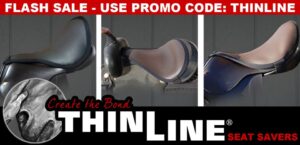Historically rider safety gear has been limited to protection of equestrians anticipating a fall.
Riders focus on products to greatly reduce damage when separated from mounts in action. These are generally limited to four:
–Helmets, riders agree every equestrian should wear one.
–Shoes, -one-inch heel to prevent the foot sliding through the stirrup and getting caught.
–Safety stirrups- . to prevent a foot from getting caught in the stirrup in the case of a fall.
–Protective vest. to protect the rib cage.
But of course, we all are hopeful we spend far more time in the tack than becoming separated from it.
When we spend many hours in the saddle how does it affect our overall physical health?
Every fitness venue has a component of long-term wear someplace in the body. For riders, it is the compression of the spine over time. Too, riding in shorter stirrups as well as a lack of core strength are associated with lower back pain. When researching rider back health articles focus primarily on core strength and flexibility of major muscle groups like hamstrings.
Horseback riding is an excellent way to stay fit- for mind, body, and soul.
The challenge lies in discovering how to stabilize a rider enough to allow him/her to really work on their strength and stretch issues while in the saddle. This is part of why we developed the ThinLine Seat saver which greatly reduces riders movement in the saddle. When you reduce movement you will increase a riders ability to exercise and work the correct muscles needed for good riding. Now add to this- shock absorption. While riders can feel and receive benefits from a ThinLine pad, where the horse is the focus of the comfort, the seat saver delivers more protection directly to the rider’s spine.
Shock absorption equates to long term safety benefits for riders.
People are living and staying fit longer, meaning they are riding longer and “the seat saver will, if used as a safety product for the spine, extend and improve rider back health, keeping them in the saddle for years to come.” (Dr. James Warson, author of “The Riders Pain-Free Back”, Trafalgar Square Publishing”) Horse Rider safety equipment now includes product for spine health:
https://thinlineglobal.eu/shop/western-saddle-pads/western-saddle-seat-saver-shock-absorbing-comfort-riders-love
Research Notes on Rider Safety, spine health:
OBJECTIVE: To investigate the possible influences of saddle type on the incidence of “lower back pain” in a cross section of equestrian riders. METHODS: 108 equestrian riders completed a questionnaire concerning their riding habits and whether they suffered from lower back pain. In particular, they were asked whether they used a traditional style/general purpose saddle (GP) or a deep seated/Western style saddle (W). RESULTS: 48% of the riders reported suffering from lower back pain, the incidence is higher in the GP saddle users (66%) than in W saddle users (23%) (P < 0.001). Female riders had a higher incidence of lower back pain than males, 58% v 27% (P < 0.005). When the genders were analyzed separately for the effect of saddle type, males using the GP and W saddles had a 33% and 6% incidence of lower back pain respectively, while females using the GP and W saddles had a 72% and 33% incidence. The highest incidence of lower back pain occurred in the GP saddle users who had been riding for more than 15 years (P < 0.07). The data also indicated a possible tendency for there to be more low back pain among riders using a short stirrup length. No other factors were found to affect the incidence of lower back pain. CONCLUSIONS: The difference in the incidence of lower back pain between the users of the two saddle types may be due to the additional comfort, cushioning, postural positioning, and stability offered by the design of the deep seated saddle. The results suggest that, while a deep seated saddle is not suited to all equestrian activities, where possible its use should be considered because of its effect in reducing the risk of lower back pain. : British Journal of Sports Medicine, June 1996, S. Quinn and S. Bird.
The following is a list generate from multiple sources, primarily physiotherapists. Common postural muscle imbalances to be worked on in the gym:
- anterior head carriage
- rounded shoulders
- rounded or hollowed back
- unleveled shoulders or pelvis
Inflexibilities: riders for Yoga.
- tight chest muscles (pull the head and shoulders forward
- tight hip flexors and quadriceps (overarch the lower back and compress the spinal joints)
- tight hamstrings ( a major cause of pain and injury to lower back and poor seated posture)
- tight calf muscles (foreword gravity line and loss of shock absorption through the lower limb and spine)
Most common postural weakness (especially in women):
- abdominal muscle group (weak core)
- neck and upper back muscles
Horse Rider safety equipment now includes product for spine health





